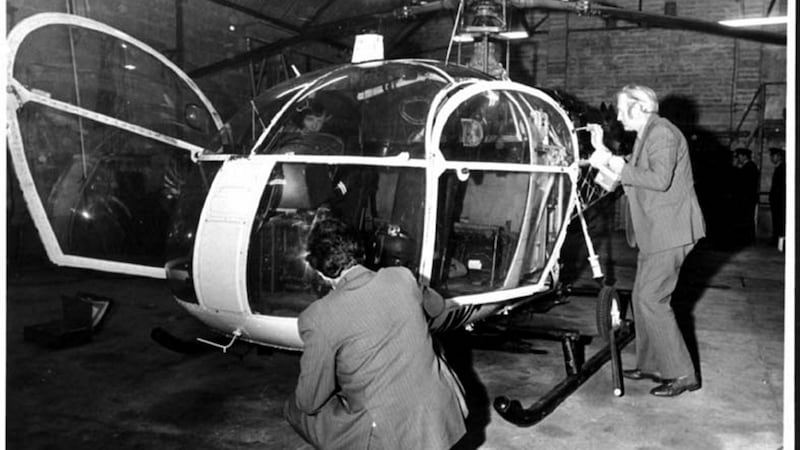At mid-morning on Tuesday, October 17th, 1972, Eileen Hickey, the Provisionals’ Officer Commanding in Armagh Prison, “arrested” Hugh Cunningham, the affable and generally well-liked governor. He would be held hostage, he was informed, against any ill-treatment of male prisoners at Long Kesh, where soldiers were retaking the camp following arson and riot.
At Armagh, troops were immediately deployed. Kept on the perimeter, they were to defend against attacks, prevent escapes and, when given the go-ahead, would enter the prison, free the hostages and restore order. All necessary force would be used and injuries and even fatalities seemed possible and imminent.
“Were you frightened,” I asked Cunningham whom I interviewed some 30 years later. Decades had passed, but his recollection was fresh and immediate: “No: but I had just had my morning coffee”. The women had treated him with courtesy, but, with an increasingly impatient bladder, he was locked in for several hours: “But I wasn’t going to put my hand up like a wee boy and ask to go to the toilet”.
By mid-afternoon a peaceful standdown had been brokered by the chaplain and officials and assurances from Long Kesh convinced the women to surrender. Cunningham was released and made his way to the lavatory with as much control as he could muster – certainly a thoughtful and unhurried pace.
A darker recollection of imprisonment in those years came from Paddy Joe McClean, rounded up in the operation that launched internment in August 1971. A special-needs schoolteacher from Beragh, not a member of the IRA, his past associations and peaceful republican sympathies had put him on the Special Branch’s deeply flawed arrest list. In custody he was further selected for “interrogation in depth”– an arrogantly diaphanous euphemism for torture.
Forcible “wall-standing” was the core of the method: splayed legs, leaning into the wall at an angle of 30 or 40 degrees with arms raised. Blows, beatings and threats ensured that the position of extreme stress would be maintained. Fear and disorientation were reinforced by other techniques – water, food and sleep deprivation, as well as heat and unceasing “white noise”. Even many later McClean was emphatic when he told me, “I was sure they’d have to kill me: they couldn’t risk this getting out”. But “they” didn’t, and McClean and 13 other “hooded men” went on to win compensation and to testify before the European Court of Human Rights: it certainly had got out.
The final part of this trilogy on Irish political prisoners covers events from the first acts of violence in the 1960s to the last releases following the Good Friday Agreement. It is based on a rich variety of sources in Ireland, England and beyond – archives, contemporary newspapers, memoirs, interviews and special collections.
It tells the tale of this particular kind of imprisonment across three jurisdictions – Northern Ireland, the Republic and England. Inevitably, the book has an ample supply of stories and is inhabited by characters of all kinds, layered with memorable incidents, plans and outcomes, consequences intended and otherwise.
Bitterness and despair sit alongside decency, compassion and hope. Rather than complicating or confusing, endlessly shifting human dimensions help to make sense of otherwise sterile institutional and political developments. The book offers different perspectives on Anglo-Irish and intra-Irish relations, and just as much on staff and inmate relations. It provides another approach to the various paramilitary bodies and breakaways, their leaders, followers, dependents, supporters and sympathisers.
Republican or loyalist, many in prison wanted to return to the paths that had brought them there. Being part of a greater thing provided a consolation of purpose to months, years and decades of captivity, behind and to come. Training, indoctrination and even broader education, were intended to heighten their capabilities when they returned to the ranks of free world activists.
But education has a way of releasing potential and transforming individuals, and captivity, although corrosive, can provide time and space for reflection. No one remains unchanged who comes through the prison’s gates, although withdrawal and paralysis may be as frequent as fresh vision and new hopes. It is nevertheless certain that the prisons and their inhabitants made a vital contribution to the long, drawn-out peace process. That final Good Friday settlement needed and was given the validation of the prisoners’ assent.
Protests and struggles were unceasing, and the book traces the numerous inventive ways in which authority was resisted. Some of this was mere attrition, wearing away by complaint and accusations. There were more dramatic conflicts and standoffs. The Maze hunger strikes of 1980-’81 attracted worldwide attention and had outcomes that none expected: both sides had concentrated on form and overlooked substance. Afterwards nothing could be the same for either side.
In England, the Price sisters’ hunger strikes at Brixton Prison eventually secured their repatriation to serve sentences in Armagh; fears that they might die in custody also changed the law on forcible feeding. Michael Gaughan and Frank Stagg subsequently persisted to the death and their remains became props in political (and literal) tussles between the UK and Irish governments on the one hand and the IRA on the other.
The strip and dirty strikes were the most remarkable of any prison campaigns anywhere. They were almost certainly more important than the hunger strikes in cutting the political path that eventually led to the Good Friday Agreement. The story of those who fashioned quite unspeakable filth, deprivation and endurance into a form of protest is truly remarkable. Roy Mason, the pugnacious Northern Ireland Secretary and hammer of the IRA, thought it was a brilliant tactic, almost impossible to counter.
And there were the families, waiting out stay-put years. The kin of those imprisoned in England served their own hard sentences, their visits requiring convoluted journeys by bus, ferry, train (and perhaps another ferry) and local taxis. All this for what at most would be a few hours of non-contact visits. Overnight accommodation could be difficult to find and IRA prisoners, held in conditions of the tightest custody, might without notice be moved across country to another high security institution. Another visit, another journey, more anxiety.
The campaigns of bombing and shootings continued in England through these years and an Irish (particularly Northern) accent could throw a fire blanket over whatever compassion might be offered to these women and their children. A visit to Parkhurst or Albany prisons on the Isle of Wight was probably the worst deal of all. It necessitated a journey of the length of England and often a cold or hostile and reception from the local community.
In the Republic, opinion and political reactions to the Northern Ireland conflict swiftly wheeled away from the anxieties and sympathies aroused by civil rights marches, weeks of bitter communal disturbances, house-burnings, population clearances and refugees across the border. The Provisional IRA’s Southern operations (and those of the splinter groups) rapidly became intolerable to government and citizens alike – murders, robberies, shootings, arms procurement, and caching.

Some spectacular prison escapes – the first one to use a helicopter, others employing arms and explosives and even a crude type of tank – openly challenged the State. The organised destruction of a large portion of Mountjoy Prison confirmed to apprehensive officials and politicians of all hues that the substance as well as the mechanism of law was threatened. Emergency legislation passed with little opposition and (not without a certain amount of grumbling) the Irish Army took up civil custodial duties at the Curragh, Portlaoise and Limerick prisons. The soldiers on the roof at Portlaoise, one official told me, performed their most vital service to democracy and the Irish State. Who was to rule, and with what mandate: armed history or the ballot box?
The other source of power in those years was the Catholic Church and its part in the politics of imprisonment has a central place in this story. Controversy ranged from what government considered to be the Provisional sympathies of the Papal Nuncio, Gaetano Alibrandi, to the outrage expressed by Cardinal Ó Fiaich following his visit to the dirty protesters at the Maze. The moderating influences of Archbishop (later Cardinal) Cahal Daly also have a place in this narrative, as have the activities of those fierce priests and talented publicists and pamphleteers, Raymond Murray and Denis Faul. The last suffered a reputational transformation when he took a central part in ending the ever more futile 1981 hunger strikes. For many republicans Faul’s long career as a civil rights critic of the Irish and UK governments was instantly erased by his discharge of what he took to be his pastoral obligations.
The other books in the trilogy are no less rich in incidents and personages. In the first volume we see the Young Ireland leaders, en route to their Australian banishment, embarrassing themselves by running up a ship’s mess bill that on arrival they couldn’t pay; O’Donovan Rossa shouting defiance and singing Fenian songs in his cell, throwing his stone-breaking hammer over the prison wall and tipping his chamber pot over the governor’s head.
The one-armed Michael Davitt put to stone-breaking at Dartmoor yet retaining an affection for English working people. At Lewes Prison the convict Eamon de Valera demanded prisoner of war status for himself and his followers, and at Pentonville, in the small hours before his execution, Roger Casement divided his last tiny possessions among his friends as keepsakes.
The middle volume takes in the Civil War and its aftermath, the establishment of Northern Ireland and the Irish Free State – each well provided with prisons and those eager to fill them. De Valera, victor in a democratic election, would have no prisoner of war nonsense in his establishments and during the second World War ground the IRA into fine powder. What was left of it spent the later war years at the Curragh, vilifying, shunning and anathematising each other. A revived organisation thought it could revive the glory days of west Cork and the Tan war and the Border Campaign supplied Belfast Prison with another group of activists. Even the Curragh briefly reopened for business – and so the wheel turned, with remarkably little movement.
Irish Political Prisoners 1960-2000: Braiding Rage and Sorrow is published by Routledge



















